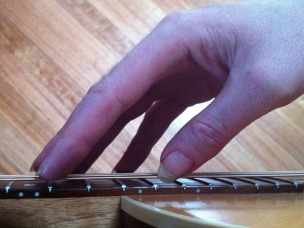How To Play Harmonics On The Guitar - Natural And Artificial Harmonics
Learning how to play harmonics on your guitar is a very creative and expressive thing to do. There are two types of harmonics you can play on the guitar. These are natural harmonics that are produced with open strings, and artificial harmonics, that are played from fretted notes.
In a nutshell, a harmonic is sounded by lightly touching a vibrating string at specific points along its length. Today, I want to introduce you to the octave harmonic. To get this type of harmonic on your guitar, you simply touch the string as it is vibrating, with your picking hand, exactly 12 frets higher from where you sounded the note.
Before I go into some examples of playing natural and artificial harmonics on your guitar, it is important to look at what your picking hand needs to do.
In regard to this, you lightly touch the string at the octave (ie. 12 frets higher from where you are fretting the note) with your index finger (i), and then sound the string with your thumb from behind the that finger. Refer to the pictures below for a clear view of the picking hand technique required to play natural and artificial harmonics on your guitar.
I have included a picture to show you how you can do this with a flat pick as well. Simply hold the pick between your thumb and middle finger so that you can free up the index finger to sound the actual harmonic.
|
With Thumb |
With Pick |
I will refer to the thumb throughout this email in regard to playing harmonics on your guitar, but you can do it with a pick if you prefer.
Natural Harmonics On Guitar
Lets get started by sounding out some natural harmonics at the 12th fret of your guitar:

In the example above, the p refers to your thumb that is picking the string, and the i is the index finger that is lightly touching the string at the 12th fret to sound the harmonic.
Take the index finger of your picking hand and place it directly over the 12th fret. Don’t place it in between the fret like you do when you sound a normal note. To sound out natural and artificial harmonics on your guitar, you need to place the index finger directly over the fret, in this case the 12th fret.
You then simply pick the string with your thumb from behind to sound the harmonic.
This step is repeated going up and then back down each string of the guitar at the 12th fret. You should hear an almost harp like sound when doing this. These are the natural harmonics of each of the open strings.
Artificial Harmonics On Guitar
To sound out some artificial harmonics on your guitar, remember these are sounded from fretted notes, take your fretting hand and bar the 3rd fret. Then repeat the process you did with your picking hand for the natural harmonics, only this time you need to do this 12 frets higher from your fretting hand position, at the 15th fret (3 + 12 = 15). You always need to be 12 frets higher to sound out the octave harmonics.
Check this out in the example below:

In the 3rd and 4th bars above, I move my fretting hand to the 5th fret and my picking hand to the 17th fret to sound the harmonics (5 + 12 = 17). It’s just basic maths really :)
Be very patient with this technique, as it can be a little tricky at first, and can take some time to get use to doing.
Natural and artificial harmonics add a whole new and very cool dimension to your guitar playing. There is so much more that you can do with them. What we have covered here though is a great start.
You might want to check out the following guitar players for some examples of the use of natural and artificial harmonics. You will learn so much by listening and learning from others who have mastered this technique.
- Lenny Breau
- Chet Atkins
- Tommy Emmanuel
- Danny Gatton
Discover the best online fingerstyle lessons for beginners

